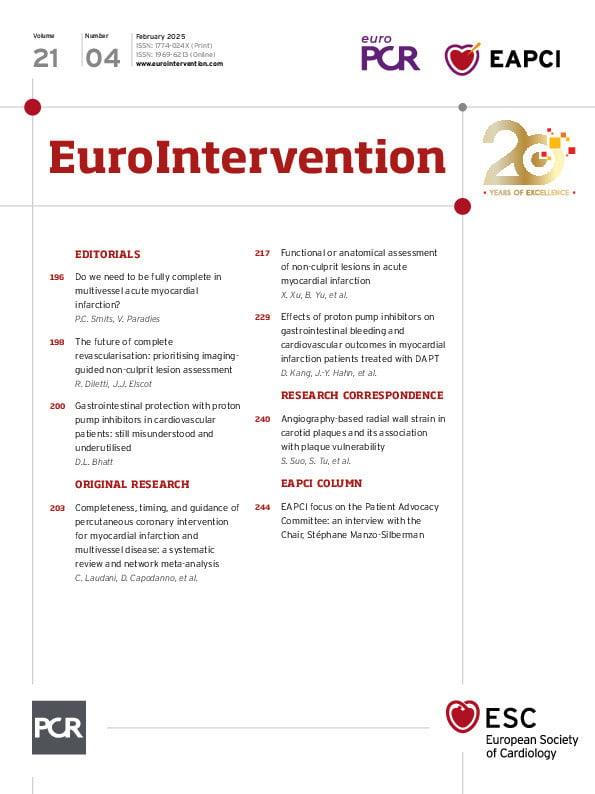Abstract
Background: Trials assessing the prognostic influence of the completeness, timing, and guidance of percutaneous coronary intervention (PCI) for haemodynamically stable acute myocardial infarction (MI) and multivessel coronary artery disease (MV-CAD) have provided heterogeneous results.
Aims: We aimed to comprehensively and simultaneously assess the available evidence on the completeness, timing, and guidance of PCI for acute MI and MV-CAD.
Methods: Major electronic databases were screened to identify randomised trials comparing at least two PCI strategies for acute MI and MV-CAD. Recurrent MI and cardiac death were the primary and co-primary outcomes. Frequentist and Bayesian 5- and 3-node network meta-analyses were conducted along with complementary analyses to explore potential sources of heterogeneity.
Results: Fourteen trials, including 14,433 patients, were pooled. In the frequentist 5-node analysis, angiography-guided immediate complete revascularisation (CR) reduced MI compared with infarct-related artery (IRA)-only revascularisation (hazard ratio [HR] 0.42, 95% confidence interval [CI]: 0.27-0.66), angiography-guided staged CR (HR 0.56, 95% CI: 0.36-0.87), and functionally guided staged CR (HR 0.37, 95% CI: 0.20-0.69). Functionally guided immediate CR was associated with reduced MI compared with IRA-only revascularisation (HR 0.53, 95% CI 0.34-0.82). The Bayesian analysis confirmed only an advantage of angiography-guided immediate CR over IRA-only revascularisation. In frequentist 3-node analysis, immediate CR reduced MI (HR 0.51, 95% CI: 0.37-0.70) and cardiac death (HR 0.68, 95% CI: 0.50-0.93) compared with IRA-only revascularisation and MI compared with staged CR (HR 0.55, 95% CI: 0.38-0.79). The Bayesian analysis did not confirm the reduction in cardiac death. CR, regardless of the type of guidance and especially when immediate, reduced the rate of any revascularisation compared with IRA-only revascularisation.
Conclusions: In haemodynamically stable patients with acute MI and non-complex MV-CAD undergoing PCI, immediate CR following successful culprit lesion treatment reduces recurrent MI compared with IRA-only revascularisation and staged CR. Whether CR is associated with reduced cardiovascular death remains uncertain.
Sign up for free!
Join us for free and access thousands of articles from EuroIntervention, as well as presentations, videos, cases from PCRonline.com

